Get free scan and check if your device is infected.
Remove it nowTo use full-featured product, you have to purchase a license for Combo Cleaner. Seven days free trial available. Combo Cleaner is owned and operated by RCS LT, the parent company of PCRisk.com.
What is ScreenSaver?
Identical to ScreenCapture.app, Spaces.app, and a number of others, ScreenSaver (also known as ScreenSaver.app) is a potentially unwanted application (PUA) and software categorized as adware. This particular app is designed to promote a dubious website (searchbaron.com), which is a fake search engine.
This search engine redirects users to bing.com using the Amazon AWS service. Typically, people download and install apps such as ScreenSaver unintentionally. When installed, most adware-type apps feed users with annoying, intrusive ads and gather data about browsing habits.
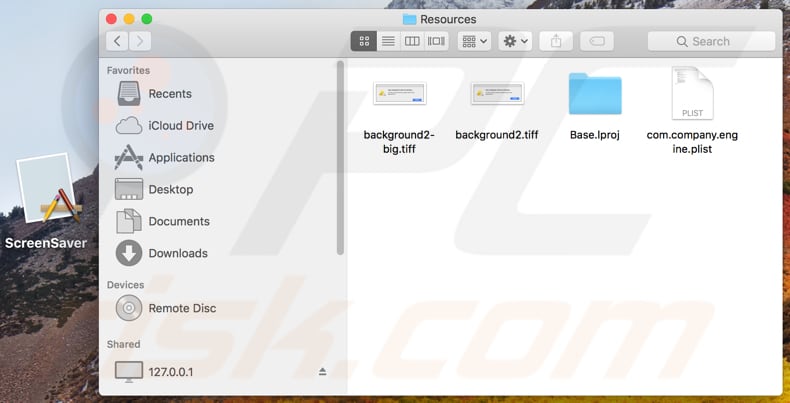
When installed, the ScreenSaver application runs in the operating system background and follows users' internet browsing activities. Each time a search query is entered into a browser, ScreenSaver forces the user to visit searchbaron.com, and then simply opens the bing.com site and displays associated search results.
It is possible that ScreenSaver might open bing.com through the Amazon AWS service. Bing is a well-known and legitimate search engine, however, this does not indicate that its developers have anything to do with the ScreenSaver adware.
The Bing search engine is safe to use, however, the searchbaron.com fake search engine (which is opened before bing.com) is used to collect information such as IP addresses, geolocations, entered search queries, addresses of visited pages, and other similar details.
Additionally, people who are forced to visit searchbaron.com by ScreenSaver are being used to generate fake traffic. Furthermore, adware-type apps usually display unwanted ads that, if clicked, lead to untrustworthy pages or even download and installation of unwanted applications.
These apps often display coupons, banners, surveys, pop-ups, and so on. Adware might also be used to gather data such as IP addresses and other information that is collected by the searchbaron.com fake search engine. People who develop these apps often misuse the information to generate revenue, or share it with third parties (possibly, cyber criminals) who also misuse it.
Apps such as ScreenSaver should be removed immediately, however, this might not be straightforward. To successfully remove ScreenSaver, follow the steps described below.
| Name | ScreenSaver.app virus |
| Threat Type | Mac malware, Mac virus |
| Symptoms | Your Mac becomes slower than normal, you see unwanted pop-up ads, you are redirected to dubious websites. |
| Distribution methods | Deceptive pop-up ads, free software installers (bundling), fake flash player installers, torrent file downloads. |
| Damage | Internet browser tracking (potential privacy issues), display of unwanted ads, redirects to dubious websites, loss of private information. |
| Malware Removal (Windows) |
To eliminate possible malware infections, scan your computer with legitimate antivirus software. Our security researchers recommend using Combo Cleaner. Download Combo CleanerTo use full-featured product, you have to purchase a license for Combo Cleaner. 7 days free trial available. Combo Cleaner is owned and operated by RCS LT, the parent company of PCRisk.com. |
Adware developers present their apps as legitimate and useful, however, people who have them installed on their browsers or operating systems are exposed to problems with browsing safety, privacy, and other issues. Rather than providing any useful features, adware-type apps display ads and collect data. They are designed only to generate revenue for their developers.
How did ScreenSaver install on my computer?
Many people download and install adware and other PUAs inadvertently. In some cases, by clicking advertisements that run scripts - these cause download and installation of a rogue application. In other cases, unwanted downloads/installations happen when people install software.
Developers bundle (include) PUAs into various download and/or installation set-ups, and hide related information in "Custom", "Advanced", and other settings. Many people leave these settings unchanged, thereby allowing unwanted apps to be downloaded and installed with other software.
How to avoid installation of potentially unwanted applications?
Download software from official and trustworthy web pages. Do not use third party downloaders, Peer-to-Peer networks such as torrent clients or eMule, dubious websites or other similar channels. Check all "Custom", "Advanced" and other similar settings that are available in each download or installation setup.
Deselect offers to install or download unwanted software, and only then complete the setup. Avoid clicking advertisements, especially if they are displayed on dubious web pages relating to gambling, adult dating, pornography, and so on. These often cause redirects to other untrustworthy web pages.
If you encounter unwanted redirects or see intrusive ads, check your browser for unwanted applications (extensions, plug-ins, and add-ons) and remove them.
Also check the list of installed programs on your computer and remove unwanted entries. If your computer is already infected with ScreenSaver, we recommend running a scan with Combo Cleaner Antivirus for Windows to automatically eliminate this adware.
Fake error message displayed by ScreenSaver application:
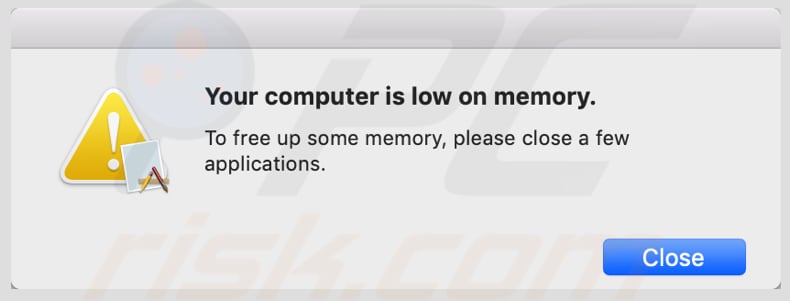
Text in this error message:
Your computer is low on memory.
To free up some memory, please close a few applications.
This adware is also designed to ask for permissions to perform various actions in the Safari web browser by displaying a pop-up with this text:
“ScreenSaver.app“ wants access to control “Safari.app“. Allowing control will provide access to documents and data in “Safari.app“, and to perform actions within that app.
Appearance of ScreenSaver adware redirecting to searchbaron.com, which, in turn, redirects to bing.com:
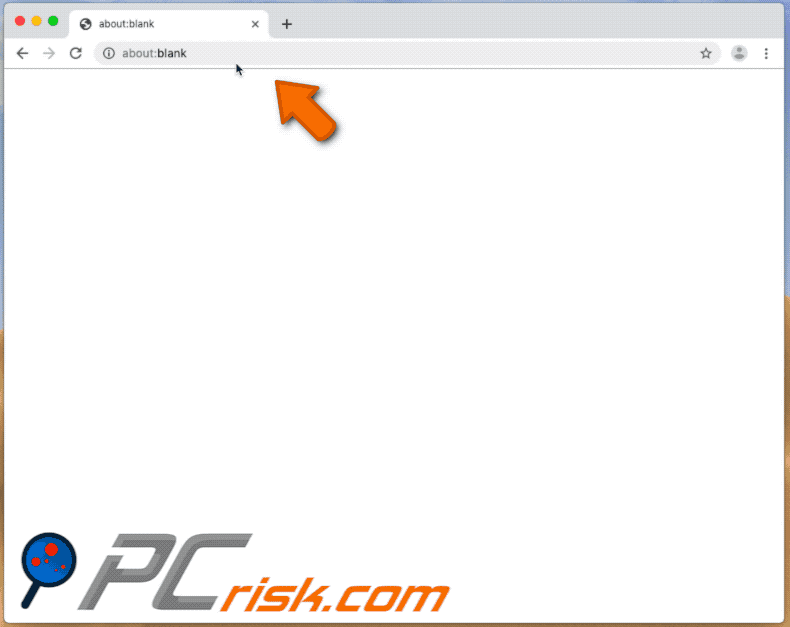
IMPORTANT NOTE!
As mentioned above, removal of the ScreenSaver application is a complicated process. It is impossible to delete it without first terminating its process. The problem is that the process is automatically re-started immediately it is terminated. Therefore, to remove this application, you must perform the following steps:
1) Navigate to the "~/Library/Application Support/.screensaver/" directory, right-click on the "ScreenSaver" application, and select "Show Package Contents":
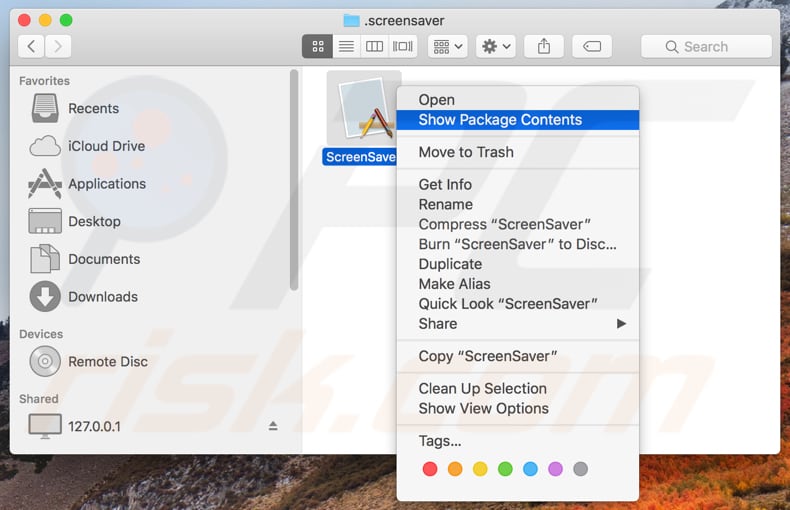
2) Navigate to the "Contents/MacOS" directory and delete the "ScreenSaver" application:
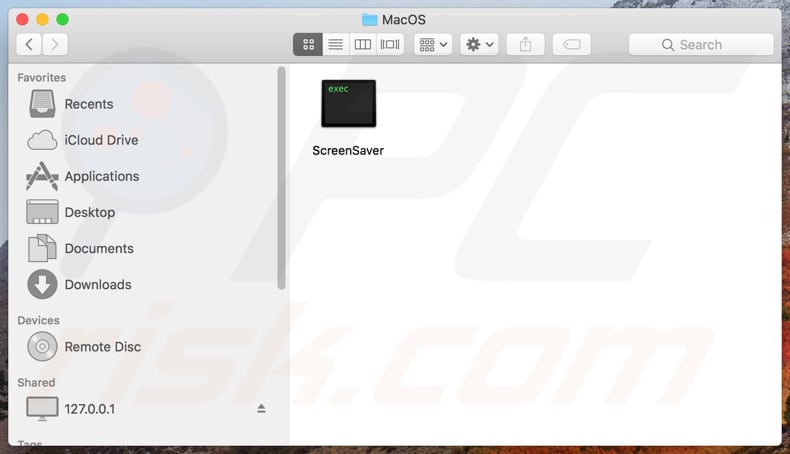
3) Once the previous steps are performed, the process of the ScreenSaver application will no longer be automatically re-started, and you can then easily terminate it and remove the remaining application files:
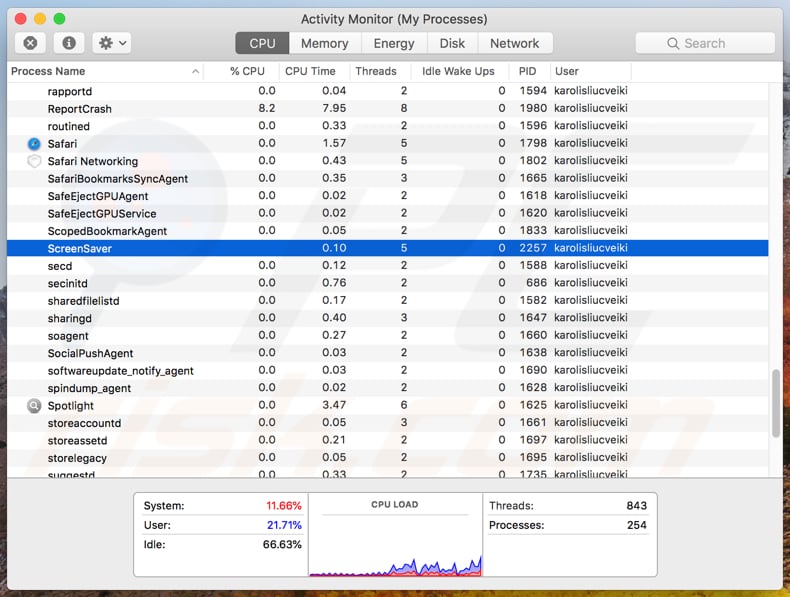
4) After removing the ScreenCapture application, you must navigate to the "/Users/Test/Library/Application Support" directory and enable the display of hidden directories. Then, search for a directory with a dubious name (e.g., ".helper", ".dir" or similar) which contains an application called "Finder".
Once located, this entire directory must be deleted. Note that MacOS has a genuine Finder application. Yet, the malicious one has a completely different icon (typically, a Terminal logo) - criminals simply use this name as a disguise:
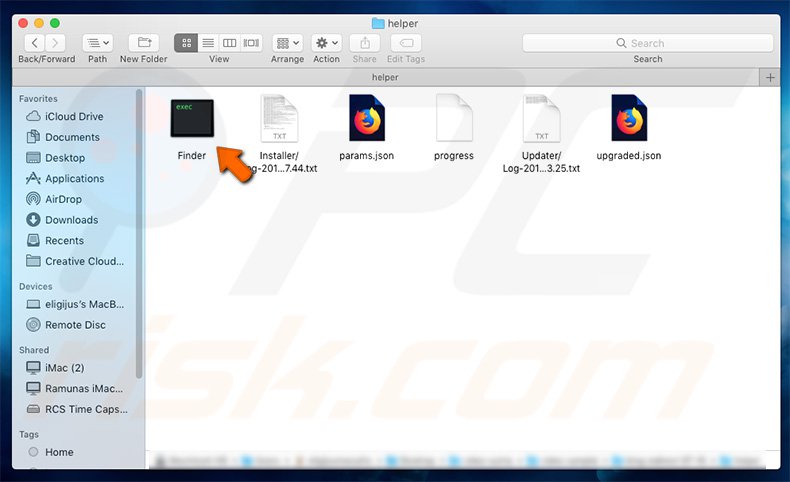
5) Finally, go to the "~/Library/LaunchAgents/" directory and find and remove the "com.xyz.abc.ScreenSaver.plist" file.
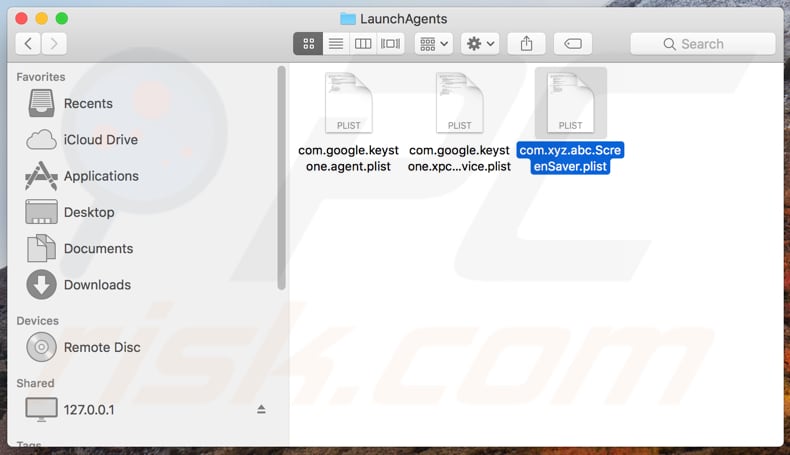
Instant automatic malware removal:
Manual threat removal might be a lengthy and complicated process that requires advanced IT skills. Combo Cleaner is a professional automatic malware removal tool that is recommended to get rid of malware. Download it by clicking the button below:
DOWNLOAD Combo CleanerBy downloading any software listed on this website you agree to our Privacy Policy and Terms of Use. To use full-featured product, you have to purchase a license for Combo Cleaner. 7 days free trial available. Combo Cleaner is owned and operated by RCS LT, the parent company of PCRisk.com.
Quick menu:
- What is ScreenSaver?
- STEP 1. Remove ScreenSaver related files and folders from OSX.
- STEP 2. Remove ScreenSaver ads from Safari.
- STEP 3. Remove ScreenSaver adware from Google Chrome.
- STEP 4. Remove ScreenSaver ads from Mozilla Firefox.
Video showing how to remove ScreenSaver adware using Combo Cleaner:
ScreenSaver adware removal:
Remove ScreenSaver-related potentially unwanted applications from your "Applications" folder:

Click the Finder icon. In the Finder window, select "Applications". In the applications folder, look for "MPlayerX", "NicePlayer", or other suspicious applications and drag them to the Trash. After removing the potentially unwanted application(s) that cause online ads, scan your Mac for any remaining unwanted components.
DOWNLOAD remover for malware infections
Combo Cleaner checks if your computer is infected with malware. To use full-featured product, you have to purchase a license for Combo Cleaner. 7 days free trial available. Combo Cleaner is owned and operated by RCS LT, the parent company of PCRisk.com.
Remove adware-related files and folders

Click the Finder icon, from the menu bar. Choose Go, and click Go to Folder...
 Check for adware generated files in the /Library/LaunchAgents/ folder:
Check for adware generated files in the /Library/LaunchAgents/ folder:

In the Go to Folder... bar, type: /Library/LaunchAgents/

In the "LaunchAgents" folder, look for any recently-added suspicious files and move them to the Trash. Examples of files generated by adware - "installmac.AppRemoval.plist", "myppes.download.plist", "mykotlerino.ltvbit.plist", "kuklorest.update.plist", etc. Adware commonly installs several files with the exact same string.
 Check for adware generated files in the ~/Library/Application Support/ folder:
Check for adware generated files in the ~/Library/Application Support/ folder:

In the Go to Folder... bar, type: ~/Library/Application Support/

In the "Application Support" folder, look for any recently-added suspicious folders. For example, "MplayerX" or "NicePlayer", and move these folders to the Trash.
 Check for adware generated files in the ~/Library/LaunchAgents/ folder:
Check for adware generated files in the ~/Library/LaunchAgents/ folder:

In the Go to Folder... bar, type: ~/Library/LaunchAgents/

In the "LaunchAgents" folder, look for any recently-added suspicious files and move them to the Trash. Examples of files generated by adware - "installmac.AppRemoval.plist", "myppes.download.plist", "mykotlerino.ltvbit.plist", "kuklorest.update.plist", etc. Adware commonly installs several files with the exact same string.
 Check for adware generated files in the /Library/LaunchDaemons/ folder:
Check for adware generated files in the /Library/LaunchDaemons/ folder:

In the "Go to Folder..." bar, type: /Library/LaunchDaemons/

In the "LaunchDaemons" folder, look for recently-added suspicious files. For example "com.aoudad.net-preferences.plist", "com.myppes.net-preferences.plist", "com.kuklorest.net-preferences.plist", "com.avickUpd.plist", etc., and move them to the Trash.
 Scan your Mac with Combo Cleaner:
Scan your Mac with Combo Cleaner:
If you have followed all the steps correctly, your Mac should be clean of infections. To ensure your system is not infected, run a scan with Combo Cleaner Antivirus. Download it HERE. After downloading the file, double click combocleaner.dmg installer. In the opened window, drag and drop the Combo Cleaner icon on top of the Applications icon. Now open your launchpad and click on the Combo Cleaner icon. Wait until Combo Cleaner updates its virus definition database and click the "Start Combo Scan" button.

Combo Cleaner will scan your Mac for malware infections. If the antivirus scan displays "no threats found" - this means that you can continue with the removal guide; otherwise, it's recommended to remove any found infections before continuing.

After removing files and folders generated by the adware, continue to remove rogue extensions from your Internet browsers.
Remove malicious extensions from Internet browsers
 Remove malicious Safari extensions:
Remove malicious Safari extensions:

Open the Safari browser, from the menu bar, select "Safari" and click "Preferences...".

In the preferences window, select "Extensions" and look for any recently-installed suspicious extensions. When located, click the "Uninstall" button next to it/them. Note that you can safely uninstall all extensions from your Safari browser - none are crucial for regular browser operation.
- If you continue to have problems with browser redirects and unwanted advertisements - Reset Safari.
 Remove malicious extensions from Google Chrome:
Remove malicious extensions from Google Chrome:

Click the Chrome menu icon ![]() (at the top right corner of Google Chrome), select "More Tools" and click "Extensions". Locate all recently-installed suspicious extensions, select these entries and click "Remove".
(at the top right corner of Google Chrome), select "More Tools" and click "Extensions". Locate all recently-installed suspicious extensions, select these entries and click "Remove".

- If you continue to have problems with browser redirects and unwanted advertisements - Reset Google Chrome.
 Remove malicious extensions from Mozilla Firefox:
Remove malicious extensions from Mozilla Firefox:

Click the Firefox menu ![]() (at the top right corner of the main window) and select "Add-ons and themes". Click "Extensions", in the opened window locate all recently-installed suspicious extensions, click on the three dots and then click "Remove".
(at the top right corner of the main window) and select "Add-ons and themes". Click "Extensions", in the opened window locate all recently-installed suspicious extensions, click on the three dots and then click "Remove".

- If you continue to have problems with browser redirects and unwanted advertisements - Reset Mozilla Firefox.
Share:

Tomas Meskauskas
Expert security researcher, professional malware analyst
I am passionate about computer security and technology. I have an experience of over 10 years working in various companies related to computer technical issue solving and Internet security. I have been working as an author and editor for pcrisk.com since 2010. Follow me on Twitter and LinkedIn to stay informed about the latest online security threats.
PCrisk security portal is brought by a company RCS LT.
Joined forces of security researchers help educate computer users about the latest online security threats. More information about the company RCS LT.
Our malware removal guides are free. However, if you want to support us you can send us a donation.
DonatePCrisk security portal is brought by a company RCS LT.
Joined forces of security researchers help educate computer users about the latest online security threats. More information about the company RCS LT.
Our malware removal guides are free. However, if you want to support us you can send us a donation.
Donate
▼ Show Discussion